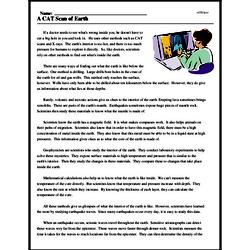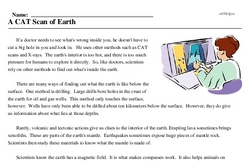A CAT Scan of Earth
If a doctor needs to see what's wrong inside you, he doesn't have to cut a big hole in you and look in. He uses other methods such as CAT scans and X-rays. The earth's interior is too hot, and there is too much pressure for humans to explore it directly. So, like doctors, scientists rely on other methods to find out what's inside the earth.
There are many ways of finding out what the earth is like below the surface. One method is drilling. Large drills bore holes in the crust of the earth for oil and gas wells. This method only touches the surface, however. Wells have only been able to be drilled about ten kilometers below the surface. However, they do give us information about what lies at those depths.
Rarely, volcanic and tectonic actions give us clues to the interior of the earth. Erupting lava sometimes brings xenoliths. These are parts of the earth's mantle. Earthquakes sometimes expose huge pieces of mantle rock. Scientists then study these materials to know what the mantle is made of.
Scientists know the earth has a magnetic field. It is what makes compasses work. It also helps animals on their paths of migration. Scientists also know that in order to have this magnetic field, there must be a high concentration of metal inside the earth. They also know that this metal must be able to be in a liquid state at high pressures. This information gives clues as to what the core of the earth is made of.
Geophysicists are scientists who study the interior of the earth. They conduct laboratory experiments to help solve these mysteries. They expose surface materials to high temperature and pressure that is similar to the earth's interior. Then they study the changes in these materials. They compare these to changes that take place inside the earth.




